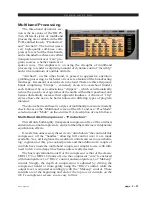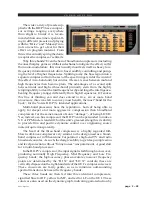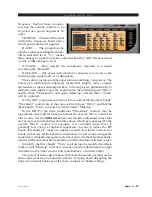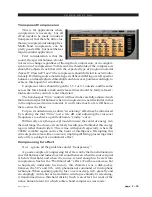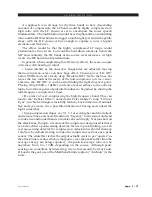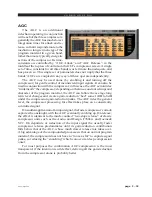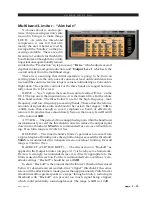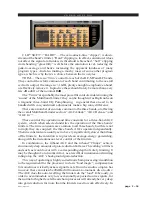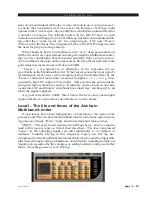
V O R S I S H D P 3 G U I
page 2 – 22
HD P3 / Aug 2006
CLIP BACKOFF—The indicated threshold on the output limiter represents
the peak output level; it is actually the level of the clipper. Ordinarily, if the
limiter is running with it’s default values for “look-ahead zero-overshoot”
(0.5mS Attack, 50mS Release) the limiter will catch pretty much everything
leaving the clipper to take care only of the occasional sub-attack-time transient
and such. If the attack time is lengthened, however, longer transients will
escape through it; at the longer attack times (say 50mS or longer) the limiter
ceases to be a peak limiter and tends to become more of an averaging detector.
(This is readily observed with nearly any peak limiter - the peak output
increases by 6 - 10dB, or even more depending on source material, when the
attack time is increasingly relaxed.)
Under this condition - long attack time, for a less “tight” sound - peak signals
many dB higher than the threshold will be allowed through the limiter. If “Clip”
is enabled, distortion as these are peremptorily removed can occur. The
“Backoff” control allows the limiter’s threshold to be reduced in relation to the
clip threshold (set by “Threshold”); this affords the running of looser limiter
attack times whilst retaining the absolute maximum output limit set by the Clip.
In general, it is set by ear; like many other settings, the degree of clipping
which is tolerable is truly subjective; no amount of blinky-lights or cute
graphics can help with this decision. Naturally, looser limiter attack times often
sound better, and the clipper helps maintain peak level control; the result though
is less “loud” in comparison to the limiter set up for zero-overshoot. A judgment
call.
The “Backoff” control, which adjusts the limiter’s threshold to a value
lower than that of the clip level (set by “Threshold”), allows one to run looser
attack times (often less “constrained” sounding) without the resulting excess
level clipping, or clipping too regularly.
POSITIVE MODULATION—This is the percentage by which the posi-
tive-going output level can exceed the negative-going, represented by the
output limiter’s “Threshold”. The FCC presently allow 125% for AM senders
in the US (some other countries being more liberal). This affords a noticeable
increase in on-air loudness.
The positive-going Limiter and Clip threshold is increased by the indicated
amount over the negative-going threshold, which remains fixed at the value set
by “Threshold”.
For all normal purposes, this control should be set to 100%.
(Should be ignored for all applications other than AM broadcast, except for
the bizarre experiments of obscure PhDs somewhere in academia.)




















